- 11 Best Long Planter Boxes to Enhance Your Garden With - January 5, 2024
- Best Bulb Planters That You Should Consider for Your Garden - January 5, 2024
- Best Fiberglass Planters That Will Look Marvelous In Your Home - December 31, 2023
Sunflowers have majestic blooms that can dot your garden with bursts of color. The show is even made more spectacular as these plants have different colors for their flowers. Red sunflowers make for a stunning contrast to the ordinary yellow sunflowers that you have.
Red sunflowers are easy to grow if you know what they need. Like ordinary common sunflowers, they need full sun and just enough water. For the most part, they can live in any kind of well-draining soil and will need protection from wildlife, pests, and fungal diseases.
Sit back and take time to learn how to do everything right when you’re growing red sunflowers.
How to Identify Red Sunflower
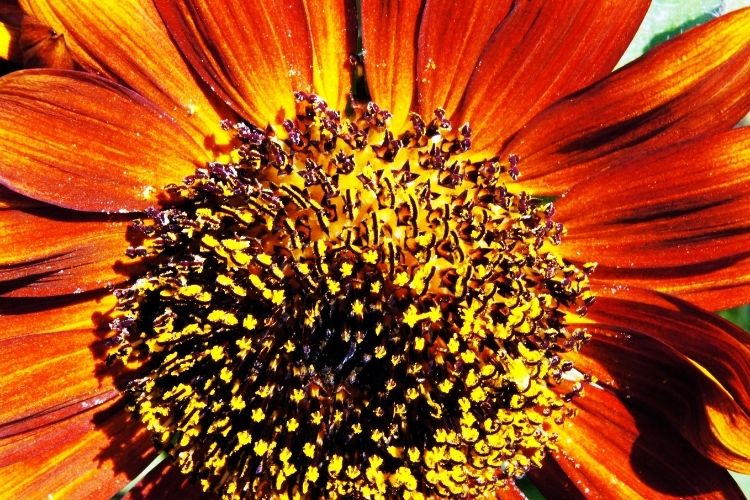
There are several red sunflower varieties that you should know, and to identify them, you will need to know what cultivars they are. Red sunflowers retain the Helianthus annuus designation because they are common sunflowers, but they have a cultivar name attached.
Helianthus Annuus ‘Black Beauty’
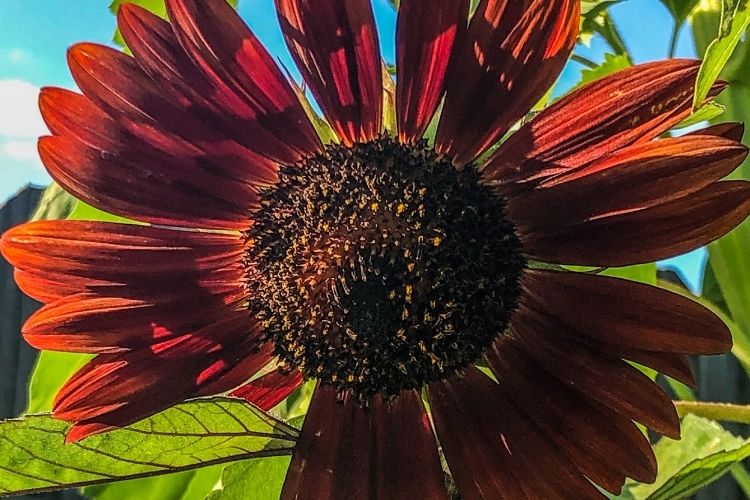
These sunflowers produce showy, intense red or maroon flowers that look almost black starting from the late spring right through the early days of fall. This variety can grow anywhere from 48 to 60 inches (120 to 150 centimeters) tall. As such, these plants can quickly grow chest high. It can live in dry to mesic soil, and the fruits are edible for birds.
The Black Beauty is often used for landscaping, cut flowers, and manufacturing dye.
Helianthus Annuus ‘Cherry Rose’
Cherry Rose is a bicolor sunflower with a dark base, then red petals, which then tapers to yellow going to the tips. This branching sunflower has different shades of red, depending on the amount of sun it gets. In full sun, you have pinking flowers, while in partial shade or low light conditions, it develops deeper red or plum petals.
Cherry Rose can get as high as five feet (1.5 meters) and can spread as wide as two to three feet (61 to 92 centimeters). The blooms can be three to four inches wide (92 to 122 centimeters). The fortunate thing is that if you have poor soil, this variety will still thrive.
Helianthus Annuus ‘Chianti’
Chianti has its dark red petals on purple stems to make it stand out in a field of equally majestic sunflowers. It is drought tolerant and has branching stems. Like most red sunflowers, it’s pollenless but can produce seeds. These sunflowers can grow to six feet (150 centimeters).
Helianthus Annuus ‘Double Dandy’
Double dandy is a dwarf sunflower variety that produces showy flowers that measure four to five inches (10 to 13 centimeters) across. It can grow within 12 to 24 inches (30 to 61 centimeters). It takes seven to 14 days for the seeds to germinate, and you will need to plant these seeds anywhere from 0.25 to 0.5 inches (6.4 to 12.7 millimeters) deep into the soil.
This variety has red petals, but sometimes, you can find multi-colored flowers. Growing in low light, it can have deep burgundy to purple colors. This dwarf sunflower can produce a lot of blooms during its flowering season.
Other Red Sunflower Varieties You Need to Know

Aside from these sunflowers, these red varieties are also beautiful and can provide striking contrasts to your garden or sunflower fields.
- Strawberry Blonde: Has rose or pink petals, but the tips are yellow or pale yellow. This type can spread up to five feet (1.5 meters) and be as tall as four to six feet (1.2 to 1.8 meters).
- Solar Flare: Has small flowers with bright yellow tips and bright red middles. It has a bigger face, which makes it look like you’re looking at a solar eclipse.
- Ms Mars: Matches a pink or red center that gradually turns to pale yellow towards the tips. This plant can grow up to 20 to 30 inches (51 to 76 centimeters) tall and can spread 18 to 24 inches (46 to 61 centimeters).
- Red Wave: Growing up to three or four feet (0.9 to 1.2 meters) tall, the Red Wave has red flowers on a dark face. It has smaller stems, but it can produce a lot of flowers. Because of its height, you can use this as an annual hedge and reward yourself with a bouquet of red sunflowers that catches the eye.
- Moulin Rouge: Moulin Rouge has deep burgundy petals with a dark face and a ring of yellow that borders these two areas. This variety can reach up to eight feet (2.4 meters) tall. You can get flowers on multiple branches!
Where Does Red Sunflower Grow
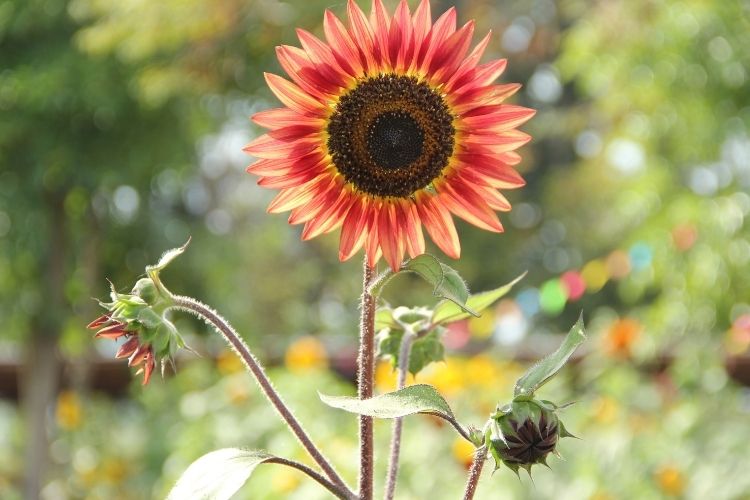
Sunflowers can grow almost anywhere. They thrive in the areas that the United States Department of Agriculture designated as zones 2 to 11.
If you live within these zones and would want to have a field of sunflowers on your property, you should find a place that has well-draining soil. Red sunflowers can thrive in mesic to dry soil, so moisture shouldn’t be a problem.
When planting red sunflowers, look for a location that has protection from strong winds. Red sunflowers can get very tall, and they may topple. If you can, plant red sunflower in groups to help each other when heavy rains and winds come.
Another thing that may help is planting these sunflowers near a fence, so you don’t have to stake each plant to keep them upright. Once the sunflowers bloom, they tend to bend because of the weight.
Uses of Red Sunflower

Sunflowers, red or not, are known for their showy flowers. So it makes sense that, for the most part, you can have cut flowers to decorate your home. According to Hunker , cut sunflower can last up to 12 days if you cut them when they’re healthy and sturdy. The flower petals should point outward or straight towards you.
It also helps to cut sunflower when it’s cool, like early morning. Put the cuttings in a bucket of water that’s around 68 degrees Fahrenheit (20 degrees Celsius) or at room temperature.
Cut around 30 inches (76.2 centimeters) below the flower and put the cut stem into the water you have. To make cut sunflowers last longer, you can add two tablespoons of lemon juice and one tablespoon of sugar to mix in every quart of water you have.
To prevent bacteria and mold from growing, add half a teaspoon of bleach to the water. You should replace the water within three days. Red sunflowers can also be used for dyeing textile or manufacturing dye. Here’s a Textile Indie video that teaches you how to dye wool with sunflower seeds.
How to Grow Red Sunflower from Seed
Red sunflowers are annual plants. They are best propagated by harvesting the seeds once the flower wilts. There is no surefire method to know when it’s time to harvest the seeds, but you can pull some seeds out and see if they are plump enough to gather.
You can also leave the blooms to dry on the plant, and the seeds will fall onto the ground, and some seedlings will grow during the following spring.
This Country Living Experience video will teach you how to properly gather the seeds from a sunflower.
Red Sunflower Growing Conditions
Believe us when we say that red sunflowers can grow in just about any soil. They can grow in poor soil, and they can be drought tolerant as well. However, red sunflowers often thrive in well-draining soil that has enough nutrients and some organic matter.
Red sunflowers grow best in temperatures ranging from 70 to 78 degrees Fahrenheit (21 to 26 degrees Celsius). They will not die if you put them in places where it’s hotter than that, but you need to make sure they get enough water.
On the other hand, as long as they get full sun, they will grow in colder climates. High humidity is also not a problem for red sunflowers.
When to Plant Red Sunflower
According to HGTV , the best time to plant red sunflowers is in the spring, once the soil gets to temperatures of 60 degrees Fahrenheit (15.6 degrees Celsius). If you want to see your red sunflowers bloom, do some succession planting where you plant another row of sunflowers after two or three weeks.
How to Plant Red Sunflower
There are several ways to start sunflowers from seeds. One easy way is to wrap them in wet tissue, put them in a sealed container, and wait for the roots to grow. When you have the first signs of roots coming out of the red sunflower seeds, you can put them in growing trays. Wait for the true leaves to sprout before transplanting them into the soil.
Remember to plant red sunflowers with enough space in between them. Generally, they like to be planted around six inches (15.2 centimeters) apart and an inch or two (2.54 to 5.1 centimeters) deep.
Red Sunflower Water Requirements
Red sunflowers can take a bit of a dry spell. However, if you want them to have more flowers, you should water them regularly.
Remember that red sunflowers may stop flowering if they don’t get enough water. Just be sure to check your red sunflowers. If you notice that they are starting to droop or if the soil looks dry, then it’s time to bring the garden hose out and give them a thorough shower.
When the red sunflowers are still small, you should water around the roots instead of near the plant. Established red sunflowers will need to be watered once a week in general. You will need to water it deeply to allow the plant to send its roots deep into the soil.
Red Sunflower Sun Requirements
Red sunflowers need six to eight hours of sunlight. So plant them in an area that receives full sun to help them have sturdy stems and many flowers.
Sunflowers have blooms that seek out the sun, and if you put them in a partially shaded area, they will bend to get as much light as possible. Because of that, they may develop weak stems that cannot hold the weight of the flowers.
Best Red Sunflower Fertilizer

When it comes to nutrients, red sunflowers need potassium and phosphorus to have those showy flowers that we all love. If they’re growing in rich soil, you may skip the feeding.
However, when they’re in poor soil, you will need to feed them. The best fertilizer is the slow-release variety.
One warning you should heed is that having overly rich soil can result in spindly red sunflowers, and that means it’s easily toppled over when they start to bloom.
Some of the fertilizers you can try include:
- Burpee Natural Organic All Purpose Granular Plant Food
- Miracle-Gro Plant Food Shake ‘N Feed Rose and Bloom Continuous Release
- Osmocote Smart-Release Plant Food Plus
Best Red Sunflower Companion Plantings

Sunflowers, in general, are not friendly to other plants. They hate weeds and may not grow as healthy when there are plants nearby. But there are some companion plants that you can try:
Onions need the same nutrients as sunflowers, but they don’t compete with each other. But more importantly, onions can keep pests and animals away. These smelly bulbs can keep deer, squirrels, and other mammals away. Sweet corn can benefit from being planted together with sunflowers. They don’t compete for the same nutrients, and sweet corn has a better taste when grown with sunflowers.
Other vegetables that can benefit from the shade provided by sunflowers and gets much-needed protection from aphids include:
- tomato
- squash
- peppers
- melons
- Lettuce
- Kale
- cucumber
Aside from these, you may also use other flowers to create a lovely flower garden with your red sunflowers. Some of the gorgeous flowers you can try to grow alongside sunflowers include:
- Zinnias
- Pink carnation
- Periwinkle
- Nasturgens
- Marigolds
- Iris
- Daylily
- Dahlia
- Cornflowers
Apart from these, you can also try growing herbs, beans, grass, and vines alongside your red sunflowers.
Red Sunflower Diseases and Common Problems
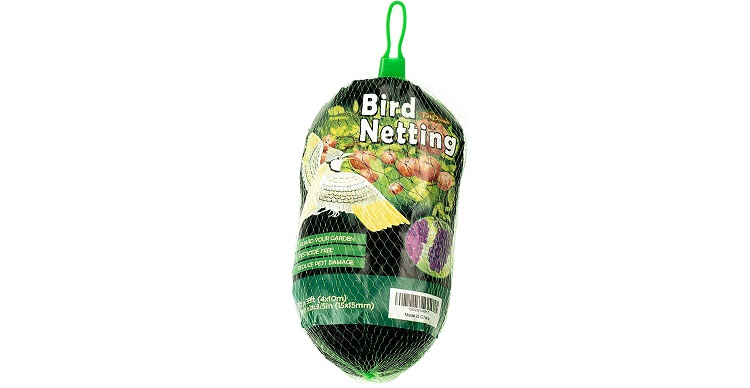
For the most part, you might have to guard your red sunflowers against birds and rodents. These animals love the sunflower seeds, and they will try to get at them whenever possible.
You might want to keep them away by using some kind of netting to cover the flowers. Get products such as:
On top of birds and rodents, you will also have to guard your sunflowers against fungi. Some of the more prevalent fungal diseases that attack sunflowers are powdery mildew, rust, and downy mildew.
To control these diseases, spray infected leaves and parts of your sunflower with a garden fungicide such as:
Red Sunflower Treatments and Maintenance
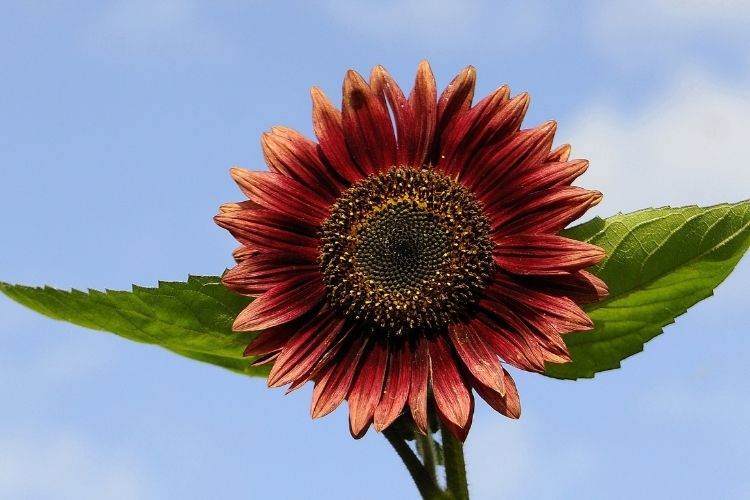
Aside from the watering and feeding, you should also give your red sunflowers the proper fungicides when they’re being attacked by fungal diseases. Plus, you may need to mulch and support them with wooden stakes.
- Mulching helps your red sunflowers thrive. Because sunflowers usually don’t like weeds growing alongside them, you can mulch around them. Not only does mulch keep the weeds at bay, but it also helps retain moisture in the soil.
- Use screens or row covers. There are a variety of animals that are drawn to red sunflower seedlings. Keep them safe with row covers. Remove these covers once your sunflowers are 12 to 24 inches (30.5 to 61 centimeters) tall.
- Use wooden stakes. If your red sunflowers start getting too tall and the stems start drooping, you can use bamboo and other types of wooden stakes to support your plants.
Red Sunflower Repotting Instructions
When growing red sunflowers , the first thing you’d learn about them is that they hate being transplanted and having their roots disturbed. Sunflowers develop a taproot, so moving it is often not recommended.
Always plan to sow sunflowers so that they could have a permanent location. If you want to start your sunflowers early, you can plant them in peat and other biodegradable containers that you can bury in the soil afterward.
If you use other types of containers, transplant your red sunflower immediately after they sprout. This means that you have less than three weeks to move your red sunflowers, or else, it may not have the long taproot it needs to survive.
Where to Buy Red Sunflower Seeds Online
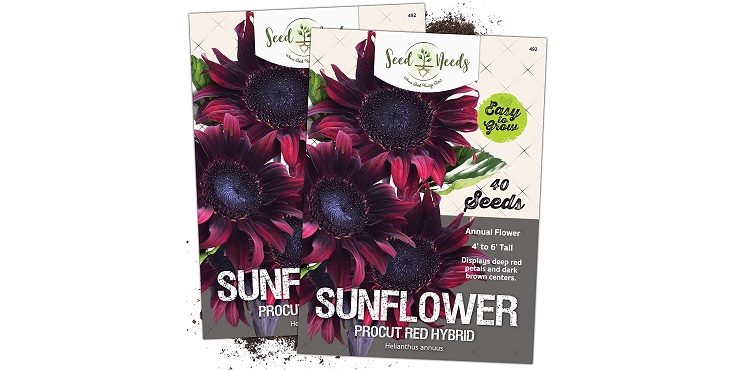
If you want to buy seeds for red sunflowers from one place, head to Sunflower Selections. They have a wide selection of red sunflowers for you to choose from.
You can also check out the listings on eBay, which have some exciting sunflower varieties, including seeds for red ones. Etsy also has seeds for sale. Search for the particular red sunflower variety you want, including:
Lowes can give you some seed packets for red sunflowers. Further, check out Amazon’s seed packets, including:
- Seed Needs, Procut Red Sunflower
- Sow Right Seeds – Velvet Queen Sunflower Seed
- UtopiaSeeds Red Sun Sunflower Seeds
- RED Sunflowers Seeds
Other retailers, you can check out include:
Where to Buy Red Sunflower Plants Online
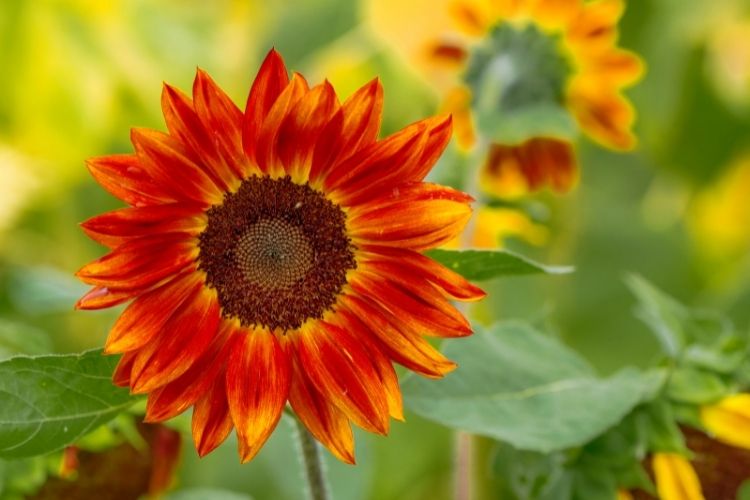
While technically, you can buy sunflower plants, you should always check to see if the topmost part of the plant is healthy. Also, if you can inspect the roots, make sure it is not rootbound. Another recommendation is to choose red sunflower plants that are planted in deep pots. Dwarf varieties in containers are also recommended.
Where can you buy red sunflower plants online? GrowJoy has some sunflower varieties for sale, such as the ProCut Plum Sunflower and the Ring of Fire .
Etsy features some sellers of live red sunflowers:
FAQs
Answer: Sunflowers turn red because of their pigments that can absorb different wavelengths of light, except for specific colors. If they can’t absorb red, then you will have red sunflowers. This pigment is called anthocyanin.
To be accurate, anthocyanin is what gives sunflowers their colors. For the most part, they can absorb most wavelengths except yellow. This is why most sunflowers have yellow or orange colors.
Further, several types of red sunflowers are available, each one having a different shade of red. Why is this? It’s a manifestation of other pigments in the flowers.
For instance, anthocyanin reacts with orange pigments to produce chestnut-red flowers. Meanwhile, wine-red varieties are when anthocyanin reacts with primrose pigments.
Answer: Depending on the variety, you will need to wait anywhere from 80 to 120 days to see your red sunflowers bloom. So you can be enjoying those red, burgundy, or crimson flowers in a little less than three months to four months after planting the seeds.
Answer: Annuals are plants that go through sprouting to flowering and seeding in just one season. The stems, leaves, and roots die within the year.
Most red sunflowers are annuals. This is in contrast to perennials, which can grow for many seasons.
Grow Healthy Red Sunflowers Today!
Given this guide, you can confidently grow red sunflowers around your garden, in your yard, and maybe have fields of these magnificently colored blooms.
Don’t be afraid to sow these seeds. They can live in any soil and can tolerate a little neglect when watering. They’re easy to grow once you know how!

